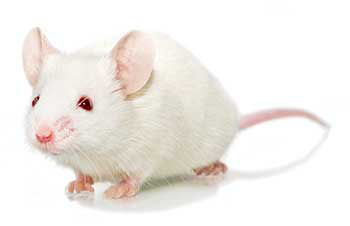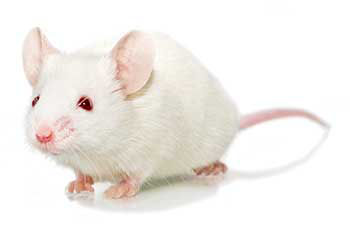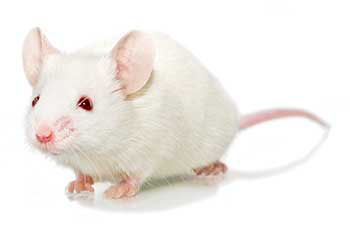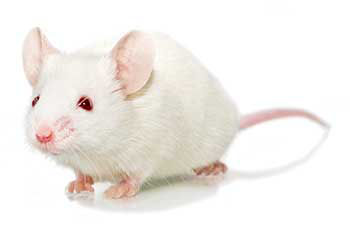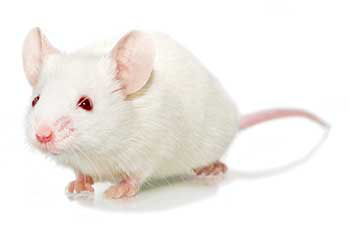Application Areas:
hIL-2 NOG

| Model No. | Nomenclature | Genotype |
|---|---|---|
| 13440-F | NOD.Cg-Prkdcscid Il2rgtm1Sug Tg(CMV-IL2)4-2Jic/JicTac | sp/sp;ko/ko;tg/wt |
| 13440-M | NOD.Cg-Prkdcscid Il2rgtm1Sug Tg(CMV-IL2)4-2Jic/JicTac | sp/sp;ko/y;tg/wt |
- Description
- Data
- Price & Licensing
- Health Report
- Overview
- Genetics
- Guides & Publications
- Applications & Therapeutic Areas
- Transit, Housing & Welfare
- Diet
Overview
Nomenclature: NOD.Cg-Prkdcscid Il2rgtm1Sug Tg(CMV-IL2)4-2Jic/JicTac
- Super immunodeficient NOG mouse expressing human IL-2 cytokine.
- Predominant differentiation of human NK cells following human HSC engraftment, with >10-fold higher CD56+ NK cell numbers compared to the base NOG mouse.
- Human NK cells developed in hIL-2 NOG mice express various NK receptors and produce both granzyme A and perforin upon stimulation.
- May be an improved model for differentiation/engraftment of IL-2 dependent cells including certain blood cancers.
- May be useful for efficacy studies involving antibody therapeutics with antibody dependent cell cytotoxcity mechanism of action.
- Applications in research involving cancer, infectious disease, immunology, regenerative medicine and human immune system engraftment.
- hIL-2 NOG mice produce human IL-2 in the range of 0.5-2.0 ng/mL as measured by MFI serology testing on DBS and serum in February 2023. Based on user feedback, this level appears sufficient to support engraftment of primary human T cells.
“Experimental Pharmacology & Oncology (EPO) GmbH uses 1st and 2nd generation NOG mice provided by Taconic for its preclinical oncology service. These mice are included in novel concepts for the development of personalized treatment options and especially suited for humanization strategies. We are very satisfied with the quality of mice, the reliability of shipment and the high level of scientific support. Further, we very much appreciate the competent and always friendly communication.”
Availability
Available now**Please note that advanced order placement is encouraged for male mice. Ordering 4 or more weeks prior to the desired shipping date is recommended when requesting males older than 3-weeks of age.
Recommended Controls
The recommended control for this model is CIEA NOG mouse.
Origin
The CIEA NOG mouse® was developed by Mamoru Ito of the Central Institute for Experimental Animals (CIEA) in Japan. The Prkdc scid mutation was identified by Mel Bosma of the Fox Chase Cancer Center in a C.B-17 congenic mouse population. This mutation was backcrossed onto the NOD/ShiJic strain at CIEA for at least eight generations. The Il2rg targeted mutation was developed by Dr. Kazuo Sugamura of Tohoku University by targeting the gene in ES cells derived from a 129 strain. Portions of exons 7 and 8 were replaced with a neo cassette. Targeted ES cells were injected into C57BL/6 blastocysts. Resultant chimeras were backcrossed onto the C57BL/6JJic background for at least eight generations. The CIEA NOG mouse® was developed by backcrossing the C57BL/6JJic-Il2rg line to the NOD/ShiJic-Prkdc scid line for a total of eight generations. The hIL-2 NOG mouse was developed by microinjecting a transgene consisting of a DNA fragment containing human IL-2 cDNA under the control of the CMV promoter into zygotes of NOD/ShiJic-Il2rg mice. Founders were backcrossed to NOG mice to establish the hIL-2 NOG line. Taconic received stock in 2014, and the line was derived through embryo transfer.
Genetics
Guides & Publications
Initial Publication:
- Ito M, Hiramatsu H, Kobayashi K, Suzue K, Kawahata M, Hioki K, Ueyama Y, Koyanagi Y, Sugamura K, Tsuji K, Heike T, Nakahata T. (2002) NOD/SCID/γ
 mouse: an excellent recipient mouse model for engraftment of human cells. Blood 100(9):3175-3182.
mouse: an excellent recipient mouse model for engraftment of human cells. Blood 100(9):3175-3182. - Fukuchi Y, Miyakawa Y, Kobayashi K, Kuramochi T, Shimamura K, Tamaoki N, Nomura T, Ueyama Y, Ito M. (1998) Cytokine dependent growth of human TF-1 leukemic cell line in human GM-CSF and IL-3 producing transgenic SCID mice. Leuk Res 22(9):837-43.
- Katano I, Takahashi T, Ito R, Kamisako T, Mizusawa T, Ka Y, Ogura T, Suemizu H, Kawakami Y, Ito M. (2015) Predominant development of mature and functional human NK cells in a novel human IL-2-producing transgenic NOG mouse. J Immunol. 194(7):3513-25.
Applications & Therapeutic Areas
- Immunology
- Inflammation
- Oncology & Immuno-Oncology
- Cell and Tissue Humanized
Transit, Housing & Welfare
Need more info? Click the live chat button or Contact Us
Packing Practices
Taconic standard practice is to recombine animals of different home cages and/or ages from a single model and sex during packing, except in specific cases where Taconic's animal welfare policy prohibits recombination due to aggression or other concerns. When an order is fulfilled with animals from more than one week of birth, this standard practice results in animals from a range of birth weeks packed together in a single TTC. When an order is fulfilled with animals from genotyped models, this standard practice results in animals from different home cages packed together in a single TTC.
Customers who wish to keep animals from different weeks of birth separated should place orders with the special instruction "Divide and label by age." Note that this special request can result in increased costs for additional Taconic Transit Cages, dividers and/or freight charges.
Taconic discourages other types of custom packing requests as they can have a negative impact on animal welfare. Learn more.
Diet
Data
Improved Human T-Cell Function & Immunotherapy Modeling with hIL-2 NOG Mice
Transgenic expression of human IL2 enables TIL-mediated tumor eradication in NOG mice
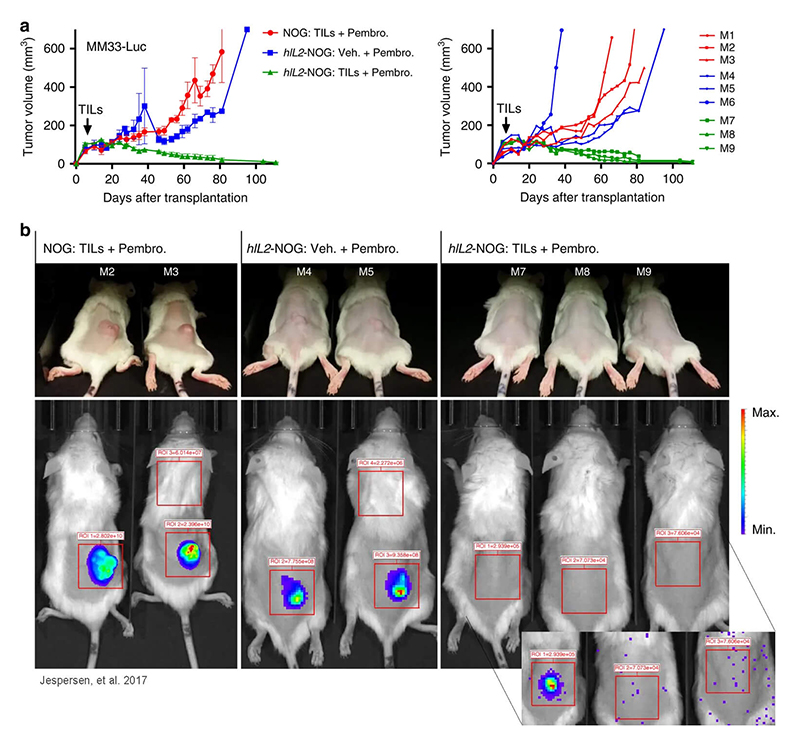
Figure 1: Transgenic expression of human IL2 enables TIL-mediated tumor eradication in NOG mice. (a) Six hIL-2 NOG transgenic mice and three NOG mice were transplanted with luciferase labeled MM33 tumor cells. After tumor growth had been confirmed by IVIS imaging, all NOG mice, and three of the hIL-2 NOG mice, were injected with autologous REP TILs and tumor growth was measured with calipers. Shown to the right are individual mice. (b) IVIS imaging to investigate if mice are disease free. Inset, very prolonged exposure yielding mostly spark signals from static electricity. Adapted from Jespersen, et al. 2017 under Creative Commons Attribution License.
Adoptive cell transfer in hIL-2 NOG mice correlates with response in patients
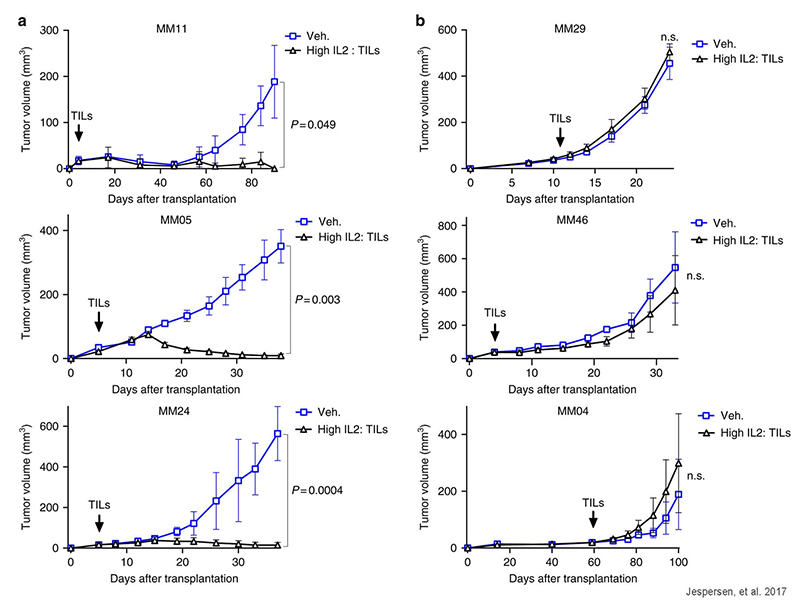
Figure 2: (a,b) Tumor growth curves of cells from three responders in the clinic (a: MM11, MM24 and MM05) and from two non-responders (b: MM04, MM46 and MM29) in hIL-2 NOG mice with high levels of hIL-2 treated either with PBS or TILs. Adapted from Jespersen, et al. 2017 under Creative Commons Attribution License.
- Licensing
- Pricing - USD
- Pricing - EUR
- Pricing - DKK
- Pricing - USD Nonprofit
- Pricing - EUR Nonprofit
- Pricing - DKK Nonprofit
- Select my Health Standard
- Get Custom Pricing Guide
hIL-2 NOG
Nonprofit users (excluding users at nonprofit foundations which are affiliated with a for-profit entity): For internal research purposes, the CIEA NOG mouse® Conditions of Use for nonprofit users apply. If you wish to perform sponsored research or fee-for-service contract research using the CIEA NOG mouse®, please inquire for access conditions.
For-profit users and users at foundations which are affiliated with for-profit entities: The CIEA NOG mouse® Conditions of Use for for-profit users apply.
The CIEA NOG mouse® is produced and distributed under license rights to the following patents and trademarks:
- Japanese Patent No. 3,753,321
- US Patent No. 7,145,055; 5,464,764; 5,487,992; 5,627,059; 5,631,153; 5,789,215; 6,204,061; 6,653,113; 6,689,610
EP Patent No. 1,338,198 - Japanese Trademark Reg. No. 4,823,423
- US Trademark Reg. No. 3,118,040
- EU Trademark Reg. No. 3,736,758
Pricing - USD
Opportunist Free (OF) Health Standard
13440 Female
13440-F Genotype sp/sp;ko/ko;tg/wt
Available now
| Age in Weeks | Quantity 1 - 999 |
|---|---|
| 4 to 10 | US$394.00 |
13440 Male
13440-M Genotype sp/sp;ko/y;tg/wt
Cohorts are reserved upon order placement and will take 4-8 weeks to fulfill. An estimated lead time will be provided to you within 2-3 business days.
| Age in Weeks | Quantity 1 - 999 |
|---|---|
| 4 to 10 | US$276.00 |
Pricing - EUR
Opportunist Free (OF) Health Standard
13440 Female
13440-F Genotype sp/sp;ko/ko;tg/wt
Available now
| Age in Weeks | Quantity 1 - 999 |
|---|---|
| 4 to 10 | 358,00 € |
13440 Male
13440-M Genotype sp/sp;ko/y;tg/wt
Cohorts are reserved upon order placement and will take 4-8 weeks to fulfill. An estimated lead time will be provided to you within 2-3 business days.
| Age in Weeks | Quantity 1 - 999 |
|---|---|
| 4 to 10 | 251,00 € |
Pricing - DKK
Opportunist Free (OF) Health Standard
13440 Female
13440-F Genotype sp/sp;ko/ko;tg/wt
Available now
| Age in Weeks | Quantity 1 - 999 |
|---|---|
| 4 to 10 | kr.2.660,00 |
13440 Male
13440-M Genotype sp/sp;ko/y;tg/wt
Cohorts are reserved upon order placement and will take 4-8 weeks to fulfill. An estimated lead time will be provided to you within 2-3 business days.
| Age in Weeks | Quantity 1 - 999 |
|---|---|
| 4 to 10 | kr.1.860,00 |
Pricing - USD Nonprofit
Opportunist Free (OF) Health Standard
13440 Female
13440-F Genotype sp/sp;ko/ko;tg/wt
Available now
| Age in Weeks | Quantity 1 - 999 |
|---|---|
| 4 to 10 | US$189.00 |
13440 Male
13440-M Genotype sp/sp;ko/y;tg/wt
Cohorts are reserved upon order placement and will take 4-8 weeks to fulfill. An estimated lead time will be provided to you within 2-3 business days.
| Age in Weeks | Quantity 1 - 999 |
|---|---|
| 4 to 10 | US$169.00 |
Pricing - EUR Nonprofit
Opportunist Free (OF) Health Standard
13440 Female
13440-F Genotype sp/sp;ko/ko;tg/wt
Available now
| Age in Weeks | Quantity 1 - 999 |
|---|---|
| 4 to 10 | 173,00 € |
13440 Male
13440-M Genotype sp/sp;ko/y;tg/wt
Cohorts are reserved upon order placement and will take 4-8 weeks to fulfill. An estimated lead time will be provided to you within 2-3 business days.
| Age in Weeks | Quantity 1 - 999 |
|---|---|
| 4 to 10 | 154,00 € |
Pricing - DKK Nonprofit
Opportunist Free (OF) Health Standard
13440 Female
13440-F Genotype sp/sp;ko/ko;tg/wt
Available now
| Age in Weeks | Quantity 1 - 999 |
|---|---|
| 4 to 10 | kr.1.279,00 |
13440 Male
13440-M Genotype sp/sp;ko/y;tg/wt
Cohorts are reserved upon order placement and will take 4-8 weeks to fulfill. An estimated lead time will be provided to you within 2-3 business days.
| Age in Weeks | Quantity 1 - 999 |
|---|---|
| 4 to 10 | kr.1.145,00 |
Select my Health Standard
Need help choosing the right Taconic Biosciences health standard for your research?
Use the Health Standard Selector to enter your exclusion list. The tool will tell you which health standards meet your requirements.
Get custom pricing guide
Schedule A Scientific Consultation
Connect directly with a member of our Scientific Solutions team who can help you select the most appropriate model and maximize your experimental success.
Related Models
Smart Select Program
Free Animal Model Trial: Quality & Compatibility Assurance
To help alleviate uncertainty in selecting a new model, we offer a free animal trial program that allows you to test the quality, consistency, and availability of Taconic’s rodent models. Pilot our most popular mouse or rat models in your facility at no cost to your organization with the Smart Select program.
- Evaluate a specific model strain, before making any financial investment
- Request up to 20 animals from one of the strains listed here to test for quality, consistency, and suitability for your experimental purpose
- Enjoy free ground shipping, where applicable (see table for more details)
















.jpg)

.jpg)
.jpg)
.jpg)
.jpg)





.jpg)


.jpg)
.jpg)




.jpg)




.jpg)

.jpg)




